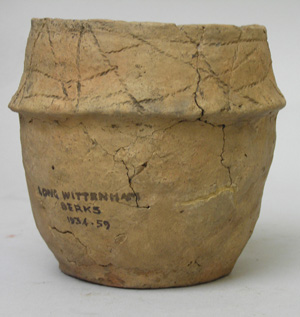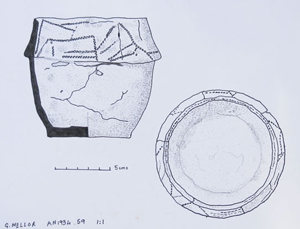
Highlights of the British Collection: East Oxford Archaeology
Object Biographies: Collared Urn from Long Wittenham, Oxfordshire
by Gillian Mellor
Alison Roberts, one of the Curators at the Ashmolean, set up a series of workshops for the volunteers on the Archeox Project. We chose an object from their collections and learned how to draw it properly as for publication. The tutor was Jeff Wallis (check out his drawings of the arrowheads we found at Minchery Paddock which are displayed on the Archeox website). My first drawing was of a flint tool and then I became acquainted with a Bronze Age Collared Urn found at Long Wittenham in Oxfordshire.
The Museum's record describes it as:
Collared Urn, Bronze Age, Long Wittenham. Found in an extensive Bronze Age urn cemetery overlain and damaged by later Anglo-Saxon burials near the River Thames.
Hand made, decorated with twisted cord impressed into collar and rim. Brownish sandy colour
Complete, little abraded but with some cracks and holes where large inclusions have dropped out.
Dimensions: H 11cm; W (at base) 7.5cm (at base of collar) 12cm; Diam.11.5cm max. All measurements approx. as vessel not entirely regular. Flat base with slight rim which suggests flattening by pressing down on a flat surface.
Excavated by John Yonge Akerman in 1860
Collared Urns were made from about 2000 cal BC. There is no evidence of a pottery industry at the time though there may have been specialist potters. Pots were probably made domestically from local clay as required. In some cases, the fabric shows signs of clay from earlier pots being ground up with new clay perhaps to represent previous generations or uses. Chemical traces from similar pots show they were used for storing or cooking food, especially milk or cheese.
The pot shows no signs of ever being exposed to fire but it does appear to contain some kind of residue. Evidence of other foods from the time suggests that a good deal of foraging continued alongside farming. In one dig a pot was found still full of nettle soup.
The urn is handmade (not wheel made) and decorated with a pattern of impressed cord around the collar and on the rim. The Collared Urn was a new style in the Bronze Age, replacing the beaker. It would have been a stylish addition to the usual set of wooden shelves used for storage. Traces of these have been found in Bronze Age round houses which have been investigated by archaeologists along with evidence of beds, pits, post holes etc. In Orkney, stone versions remain at Skara Brae.
The corded decoration may have had symbolic meaning. Lime bast fibres (inner bark fibres soaked and spun) were used for fishing nets and for slings for pots – Long Wittenham is on the Thames –so there might have been a fishing connection. Hemp was also used to make cord so perhaps the contents of the pot were to be used to achieve ‘alternative’ states of mind. Hemp was stronger than lime but lime was lightweight and pliable.
It was a common practice at the time to re-use domestic pots as burial or cremation urns. This pot was buried in a cemetery with many others at Long Wittenham. Centuries later, an Anglo-Saxon cemetery was dug into it and the earlier burials disturbed and some of the urns smashed.
In 1860 an ‘antiquary’, Mr John Tonge Akerman (at the invitation of the local vicar the Rev J.C. Clutterbuck) investigated the Anglo-Saxon burials and reported on the number of broken pots with cremation remains or bones in them. Mr Akerman reported to the Society of Antiquaries that most of the pots were smashed ‘beyond recovery’. We know that two complete pots survived because they are now in the Ashmolean. They were lucky because Mr Akerman was not really interested in them, only in the Anglo-Saxon grave goods. His report mentions two pots, one with cremation remains and one ‘plait pot with bones’. The accession book for the Ashmolean mentions the larger pot with its cremation and the smaller ‘plait’ pot but the bones have disappeared
The pots were originally deposited at the Natural History Museum but were moved to the Ashmolean as part of the process of rationalising the collections. The Ashmolean had housed Ashmole’s original natural history specimens and when these were moved to the new museum, they decided (not without controversy) to develop the archaeology collections and various items were exchanged up until the 1930s.

Collared Urn (AN1934.59)
Author's ilustration of the collared urn

Further Information
Archaeologia Vol 38 Issue 02 Jan 1861 pp27-352
Longworth, I. 1984. Collared Urns of the Bronze Age in Great Britain and Ireland. Cambridge University Press.
Parker Pearson, M. 2012 Stonehenge: Exploring the Greatest Stone Age Mystery. Simon & Schuster pp148-9.
Ṥoberl, L, Pollard, J. and Evershed, R. 2009. "Pots for the afterlife: organic residue analysis of British Bronze Age pottery from funerary contexts". Past 63:6-8.
Find out more about:
- Related Story: The Collared Urn - A Story
- Oxfordshire's Historic Archives
- British Collections Online - searchable database of the collection
July 2014
